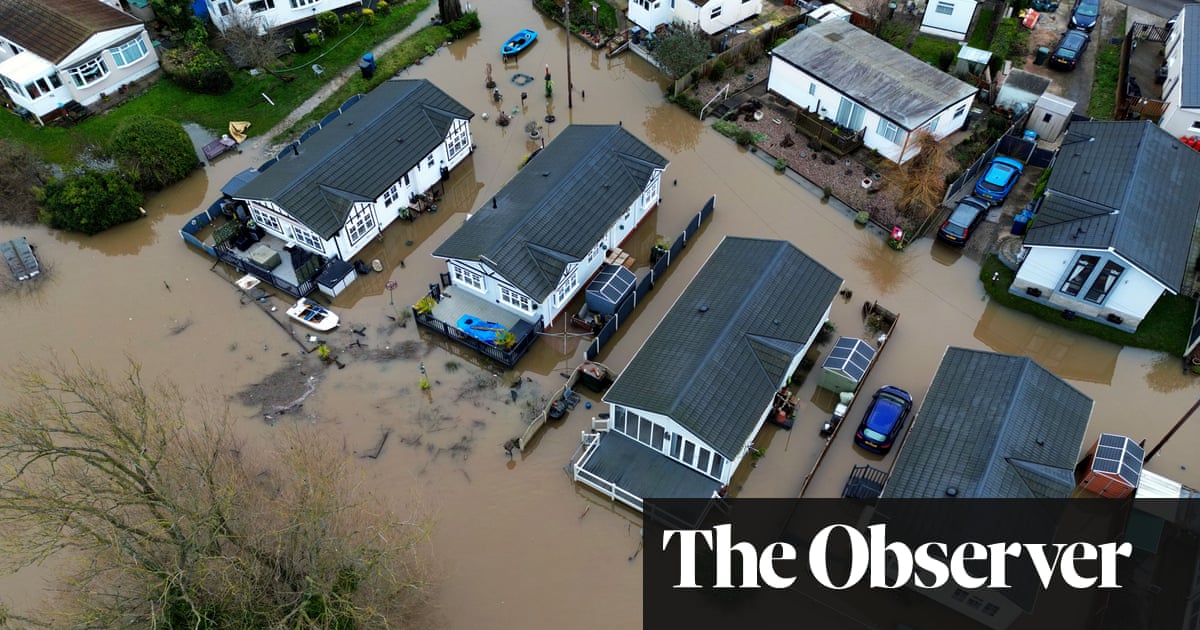
People affected by this month’s floods will face the same problems in future because their communities cannot access government support, campaigners have warned.
Small towns and villages affected by floods in England and Wales can ask for flood defences and mitigation through their council or the Environment Agency (EA), but are being turned down because they cannot make a business case, according to the National Flood Forum.
Heather Shepherd, director of operations at the NFF, a charity which supports flood victims, said: “There’s a lady who’s been flooded three times in the past year in Shrewsbury. The EA and the council can’t access help for her because they have to apply for funding – and they don’t qualify.
“I just spoke to Worcestershire council and Shropshire council yesterday. They have people that flood over and over and over again, but they have no hope, because they don’t add up to make a good business case to be able to mitigate the flooding. So it goes on and on. It’s utterly crazy.”
The woman in Shrewsbury already has extensive flood mitigation measures in her home but these were not enough to cope with last week’s downpours, Shepherd said. Storm Henk soaked countryside that had already absorbed heavy rainfall from storms Babet and Ciarán in the past three months. More than 200 flood warnings across the country remained active on Saturday afternoon.
Nottinghamshire county council urged people in 10 towns and villages in the northern part of the county to consider evacuating as the River Trent was at risk of flooding.
“The River Trent has now reached a record peak at the Torksey Lock gauge in Nottinghamshire, with rising waters surpassing the historic levels set in 2000,” it warned. “This means that your communities are at an increased risk of flooding.”
David Walters, who has run Cresslands Touring Park in south Lincolnshire for the past 11 years, said it would cost £20,000 to repair flood damage caused last week. “Debris off the fields that the water has washed through is completely strewn all over everything and everything stinks to high heaven. Because there’s no running water, I can’t clean or mop anything.”
The EA warned there is also a risk of significant river flooding from the Severn around Gloucester and the Thames in Oxfordshire because of the prolonged wet weather and intense rainfall. About 1,800 properties have been flooded so far during Storm Henk.
Jeremy Hunt, the chancellor, defended government action on flooding after a National Audit Office reported that 500 of 2,000 new flood defence projects had been dropped, and the number of properties that will receive better protection from flooding by 2027 had been cut by 40%.
He said that flood protection was “a priority” and that since 2015 the government had protected nearly 400,000 homes.
“The reason the National Audit Office say that is because of the impact of inflation, and that is why our number one priority is to bring down inflation,” he said, since inflation had made projects more expensive.
Katharine Smith, flood duty manager at the EA, said that teams had been out operating flood defences and clearing watercourses. “So far, more than 45,000 properties have been protected in the last few days,” she said. “We also urge people not to drive through flood water and follow advice of local emergency services on the roads – flood water is often deeper than it looks and just 30cm of flowing water is enough to float your car.”
The government’s policy for people affected by floods focuses on resilience, which means transforming homes so that they can recover from flooding more quickly. That means installing flood-resistant doors, replacing plasterwork, having solid floors without carpets, and raising boilers and electrical devices above the high water line.
People wanting to build resilience measures can apply for a one-off grant of £5,000, or for up to £10,000 through the Flood Re government-backed insurance scheme. Shepherd said that homeowners often needed to spend as much as £70,000.
“We’re going to see this more and more, bigger and harsher floods,” said Shepherd. “Climate change is throwing up ever increasing challenges. The government is eager to tell us that investment is larger than in the past, but flooding is clearly underfunded.”
Shepherd said the NFF helpline was getting increasing numbers of calls from people who had been flooded for the first time and blamed the disaster on new housing estates built nearby.
In 2020, the thinktank Bright Blue estimated that 70,000 homes had been built in high-risk areas since 2008 and others have estimated that 5,000 to 9,000 homes a year are approved on flood zone three areas at the highest risk.
Jonathan Werran, the chief executive of Localis, a thinktank focused on local affairs, said that no single agency was responsible for addressing flooding.
“The planning system encourages and incentivises folly,” he said. “We must not incentivise any more building of houses in high-risk flood plain areas.” Local authorities responsible for those areas “must be given a pass”, he said, rather than house-building targets which encouraged them to do “very foolish things”.












